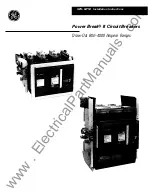
1.4.2 Tripping Operation:
Now with previous reference consider tripping spring
is in charged condition. Fig. H shows the charged
condition of the tripping spring and internal detail for
position of different components. Latch Assembly (La)
and (Lb) engaged with each other. Engagement of
(La) and (Lb) will confirm that breaker will not open in
this condition unless and until the opening command
is initiated.
If trip command is initiated now, it will pull the latch
(Ref. Fig. I). Hence its engagement with the latch
assembly will break. This will move the latch
assembly La in downward direction. Downward
movement of latch assembly will release the latch Lb.
Hence there is no more pressure or any engagement
that will retain the current poison of arm and leverage.
Armand leverages are free to move now. As previously
discussed these components are directly connected
to charging shaft. Tripping spring directly exerts
pressure on the shaft via tripping lever. As leverage
becomes free to move tripping spring will pull back
the tripping lever and open the circuit breaker.
Lever
Tripping
Cam
Assembly
Fig. H
Circuit-Breaker in Close condition, ready for tripping operation.
Latch
TRIPPING
SPRING
Mechanism
Lever
Lever
TRIPPING COMMAND
PART C Operating Mechanism working principle & maintenance
38
Assembly
Latch
TRIPPING
SPRING
Mechanism
Lever
C
lo
s
in
g
i
n
te
rl
o
c
k
Latch
Lb











































